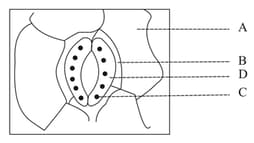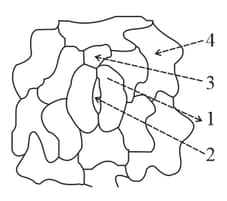How are photosynthesis and transpiration related?
Important Questions on Transport in Plants
Study the diagram and the list given below.

i) Chloroplast
ii) Epidermal cell
iii) Guard cell
iv) Subsidiary cell
v) Stomatal pore
The correct match is
Given below is a diagram of the stomatal apparatus. Match the labels with the corresponding names of the compounds.

Choose the correct combination.
Identify the correct match of the type of water given in column-I and its character in column-II and select the correct option.
| Column-I | Column-II | ||
| (i) | Capillary water | (a) | present in the form of hydrated oxides of silicon and aluminium. |
| (ii) | Hygroscopic water | (b) | goes down through large pores between soil particles and reaches the water table. |
| (iii) | Combined water | (c) | held in between small non-colloidal soil particles. |
| (iv) | Gravitational water | (d) | held tightly around soil particles by adhesive forces. |
Given below are two statements:
Statement I: The forces generated by transpiration can create pressures sufficient to lift a xylem sized column of water over 130 metres high.
Statement II: Transpiration cools leaf surfaces, sometimes 10 to 15 degrees, by evaporative cooling.
In the light of the above statements, choose the most appropriate answer from the options given below:
The containers and have litre of pure water and litre of sugar solution, respectively. Which one of the following statements would be correct regarding their water potential and osmotic potential
*Note: There were errors in original KVPY papers, and thus the options are modified here.

